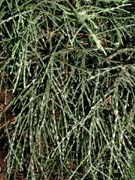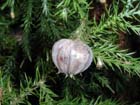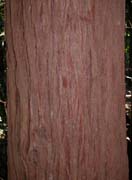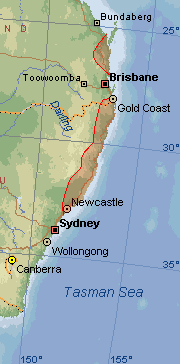
Canopy of tree in closed forest, Port Maquarie, New South Wales [Trevor Hinchliffe].

Tree in closed forest [Trevor Hinchliffe].

Mature foliage of tree in Port Maquarie, New South Wales [Trevor Hinchliffe].

Juvenile foliage and female cone of tree in Port Maquarie, New South Wales [Trevor Hinchliffe].

Bark of tree in Port Maquarie, New South Wales [Trevor Hinchliffe].

Distribution of Callitris macleayana (Bowman and Harris 1995). Basemap from Expedia Maps. You can also create a highly detailed map, and access specimen data, using the "search" function at the Australia Virtual Herbarium.

Conservation Status

Callitris macleayana
(F. Mueller) F. Mueller 1860
Common names
Stringybark pine (Harden 1990), brush cypress pine (Ash 1983), brush cypress, stringybark cypress, cypress pine, kerosene Pine, Port Macquarie pine, stringybark cypress pine (IBIS).
Taxonomic notes
Syn: C. parlatorei (Silba 1986).
Description
A straight tree growing up to 40 m tall. Bark is subfibrous, furrowed. Branches are spreading. Mature leaves are 2-3 mm long, dorsal surface acutely keeled; juvenile leaves 10-15 mm long, sharp-pointed, often remaining even on shoots bearing cones (see photo). Cones, 20-30 mm in diameter, are solitary on thick fruiting branchlets, remaining on the branches long after maturity. Cone scales 6 (8 if borne on juvenile branches), each scale with a small dorsal point near the apex; columella very short, 3-lobed or 3-partite or 4-lobed in cones on juvenile branches (Harden 1990).
Distribution and Ecology
Australia: New South Wales and Queensland. It grows in two regions; one from Newcastle in NSW to SE Queensland, and the other in higher altitudes of north-east Queensland in the Atherton and Mt. Windsor Tablelands. This species prefers moist habitats, close to rainforest, and usually is found growing in poor soils (Iedema [no date]).
Zone 10 (cold hardiness limit between -1°C and +4.4°C) (Bannister and Neuner 2001).
Remarkable Specimens
The greatest known age is 62 years (Ash 1983), though it seems likely that substantially greater ages are attainable.
Ethnobotany
I have found no records of cultural use, but the scientific potential for use in dendrochronological research has been looked at: "Growth rings were examined in trees of Callitris macleayana from the Atherton Tableland in Queensland, Australia. The climate is tropical with a distinct dry season that induces regular annual growth rings. A correlation of 0.74 was found between annual ring widths and the duration of the wet seasons. The potential of this species for dendrochronological study is apparent" (Ash 1983).
Observations
Remarks
Citations
Ash, J. 1983. Tree rings in Callitris macleayana F. Muell. Australian Journal of Botany 31: 277-281.
IBIS (Integrated Botanical Information System). [no date]. Australian plant common name database. www.anbg.gov.au/common.names/, accessed 2012.11.23.
Iedema, Wade. [no date]. Stringybark pine - Lamington National Park. http://lamington.nrsm.uq.edu.au/docs/Plant/stringybarkpine.htm, accessed 2001.07.17, now defunct.
Mueller, F.J.H. von. 1860. Essay on the plants collected by Mr. Eugene Fitzalan, during Lieut. Smith's expedition to the estuary of the Burdekin. Melbourne: John Ferres, Government Printer. P.19. Available: Hathi Trust, accessed 2012.11.25.
See also
Farjon (2005) provides a detailed account, with illustrations.
Hauser, J. 1992. Fragments of green - an identification field guide for rainforest plants of the greater Brisbane region. Queensland: Rainforest Conservation Society.
Nicholson, Nan and Hugh. 1985, 1988, 1991,1994. Australian Rainforest Plants I, II, III & IV. Australia: Terania Rainforest Publishing.






